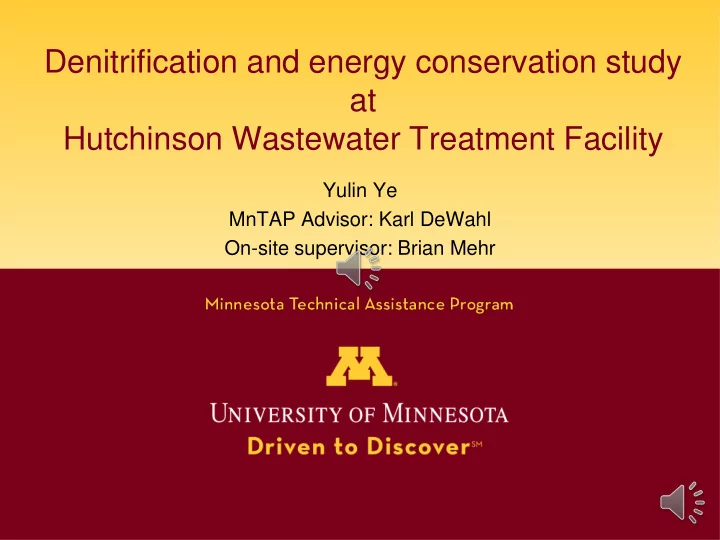

Denitrification and energy conservation study at Hutchinson Wastewater Treatment Facility Yulin Ye MnTAP Advisor: Karl DeWahl On-site supervisor: Brian Mehr
Facility Overview Hutchinson Wastewater Treatment Facility • Year in service: 1988 • Designed flow rate: 3.67 million gallon per day • Treatment capacity: 7,000 lbs Biological Oxygen Demand (BOD) per day • Energy consumption: ~100,000 kWh per month
Facility Overview (cont.)
Motivations for Change • Process modification for nitrate removal • Opportunity in energy conservation through aeration control
Approach • Literature review • Bench study of Denitrification rate • Monitoring the power of aeration device • Plant trials and data collection
Background of denitrification Denitrification: the biological process that convert nitrate to harmless nitrogen gas − − + 2 𝑂𝑃 + 10 𝑓 + 12 𝐼 → 𝑂 2 ↑ + 6 𝐼 2 𝑃 3 Process requirement: • Absent of oxygen (anoxic condition) • Present of Microorganism (facultative aerobes) and readily biodegradable organics
Denitrification rate study 𝑒𝑇 𝑠 𝐸 = − 𝑒𝑢 = 𝑦𝐿 𝑡 — N/ L∙h r D : denitrification rate, mg NO 3 — N/L S: nitrate concentration, mg NO 3 x: denitrification bacteria concentration expressed as mixed liquor volatile suspended solid (MLVSS), mg MLVSS/L — N/mg MLVSS∙h K s : specific denitrification rate, mg NO 3
Denitrification rate study Denitrification rate V.S temperature 1 specific denitrification rate, 0.8 mg N/g MLVSS/h 0.6 0.4 0.2 0 0 5 10 15 20 25 Temperature, Celsius
Modification I West ditch East ditch Number of aeration rotors 1 2 D.O maintaining point 0.5 mg/L 2.0 mg/L
Modification I (cont.) • An anoxic zone which is approx. 50% of total activated sludge reactor volume was developed • The modification removed 15-20mg/L more nitrate than the experiment control • System instability caused by inadequate mixing was observed by the end of the test • No significant energy saving
Modification II Single-ditch operation • West ditch was shut down • DO maintaining point was lowered from 2mg/L to 1mg/L
Modification II (cont.) • No degradation in treatment quality • Energy consumption was reduced by nearly a half, resulting in $3,500 in monthly electricity bill • Small anoxic zone was developed but improvement on denitrification was not significant
Successful Process Changes Nitrate concentration, Energy saved Savings in monthly mg/L per month, kWh electricity bill 26 ± 7 Baseline - - 12 ± 4 Modification I 3,263 $424.88 Modification II - 40,089 $3,480.08 • Modification I enhances nitrate removal of the activated sludge system and slightly reduces energy usage • Modification II cut energy usage by a half while have limited improvement on nitrate removal
Recommended Future Projects • To find a optimized mixing strategy for Modification I • To test methanol as external carbon source for complete nitrate removal
Personal Benefits • Understanding in process control • Industrial environment exposure • Project management • Communication skill
Thank you!
Recommend
More recommend